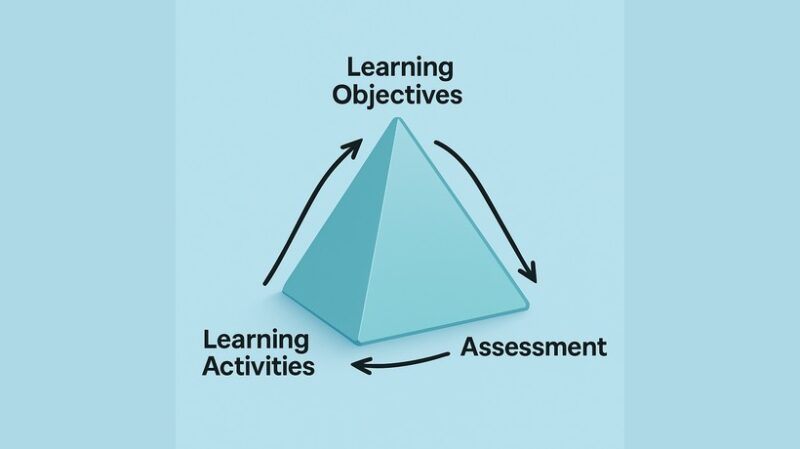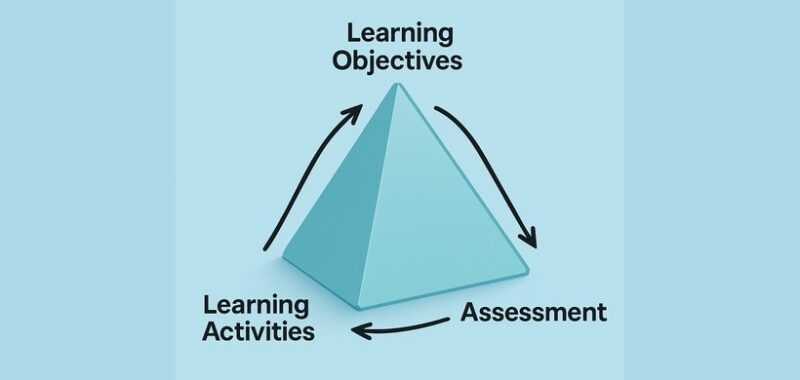
What Is The Magic Triangle Of Learning?
Ever wonder why some training programs are successful, while others aren’t? It has happened to most people: finishing a course, getting a certificate, but not remembering anything later. On the other hand, there are some training experiences that actually stick and leave people applying what they learned for a long time. So, what’s the difference? It all has to do with how a course is structured. And that’s where the Magic Triangle of Learning comes in.
This framework combines three key elements that every effective learning experience should have: learning objectives, activities, and assessments. When all three are aligned, the learning becomes clear, purposeful, and memorable. To make more sense of it, picture a triangle, with arrows flowing between each point. Objectives shape your activities, activities prepare learners for assessments, and assessments show whether your objectives were met. The idea has its roots in Instructional Design, particularly in constructive alignment, a term popularized by educational theorist John Biggs. It’s widely used in both academic settings and workplace training, and that’s because it’s effective. Let’s see how the Magic Triangle of Learning works, particularly in eLearning.
The 3 Pillars Of The Magic Triangle Of Learning
Pillar 1: Learning Objectives
Learning objectives are the secret behind every well-designed course or training program. Without them, learners don’t know where they’re headed, and instructors risk creating courses that lead nowhere useful. Learning objectives are clear, measurable statements that highlight exactly what learners should be able to do by the end of a session or module. When crafting your own objectives, try using active verbs, like “identify,” “create,” “apply,” or “analyze.” Also, keep them focused on learners, such as what they will do and not what you’ll teach them. Lastly, always align them with broader goals, whether that’s for a company, compliance, or a personal development plan.
Pillar 2: Learning Activities
Learning objectives tell us what learners need to know or do, but learning activities are how they get there. They are the hands-on experiences that help learners absorb, apply, and retain new information. These can be group discussions, interactive eLearning modules, case studies, role-playing exercises, or games. The point is to create opportunities where learners interact with the information, not just receive it. However, not all activities are the same. For them to be truly effective, they need to be related to your learning objectives. For example, if your goal is to help someone handle conflicts at work, then a role-play scenario or a simulation is going to be more impactful than a quiz. You also need to keep in mind that different people learn in different ways. So, including various activity types helps ensure everyone stays engaged and gets something meaningful from the experience.
Pillar 3: Assessment
So, you’ve set clear learning objectives and designed engaging activities. Now, how do you know if all this was actually effective? Through assessments, which are the third pillar of the Magic Triangle of Learning. Assessments differ, but at their core, they’re just tools to check whether learners have met your objectives. There are two main types: formative and summative. Formative assessments are like learning checkpoints, such as short quizzes, discussion prompts, or feedback during activities. These help learners stay on track. Summative assessments, on the other hand, happen at the end, such as final projects, presentations, or skill demonstrations. These are more like evidence of how effective learning was. Again, the key to meaningful assessment is alignment. Your quizzes, assignments, or tests should directly tie to the objectives you set at the beginning.
What Happens When The 3 Pillars Align?
So, what actually happens when learning objectives, activities, and assessments all align? Learning becomes clear, purposeful, and effective. First of all, it sparks motivation. Knowing exactly what to do, how it connects to goals, and what it takes to reach success makes learners more confident. They’re eager to engage with the content as they know it’s relevant and plays a role in how they’ll be evaluated. For Instructional Designers, it streamlines the entire design process. When the objectives are clear, choosing the right activities and designing assessments that truly matter is easier.
What Happens In Case Of Misalignment?
Even the best learning programs can fail if one piece of the triangle is off. Unfortunately, this happens often. One common issue is when activities feel disconnected from the learning objectives. If learners can’t see how an activity helps them reach the objective, engagement drops, and they don’t really learn. Then there are also assessments that don’t match what was taught. This can be frustrating for learners. They might spend hours learning a concept through videos and examples, only to be tested on something entirely different or theoretical. Learners get confused when objectives, activities, and assessments aren’t in sync. It feels unfair, and it isn’t good for retention.
How To Put It Into Practice In eLearning
Clear Objectives
To create clear objectives for your eLearning course, instead of generic goals, use statements that are actionable, measurable, and allow no guessing. This way, the learner knows exactly what’s expected, and Instructional Designers know exactly what to build.
Purposeful Activities
In eLearning, you need to be a bit more creative when designing meaningful activities. Instead of passive methods, like slides, lectures, or videos, use interactive activities with real-world relevance. For instance, scenarios where learners make decisions and see outcomes, stories, or simulations.
Meaningful Assessments
Many eLearning assessments only test recalling knowledge, not its application. But in the real world, learners must be able to do things with what they’ve learned. To make assessments meaningful, ask if the test shows whether the learner can actually meet the objective. For example, if the objective is to learn how to run a Google Ads campaign, it would be more meaningful to assign them a project where they’d create and run a mock campaign.
Using Data And Analytics
One of the biggest perks of digital learning is data. You can see what learners click on, how long they spend on each course, where they drop off, and what they get wrong most often. But you need to learn how to use it. If you notice that learners get a specific activity wrong, see what you can improve. Similarly, if learners abandon a course or a particular section, try making it more engaging.
Conclusion
Whether you’re creating a university course, a corporate training program, or an online module, the Magic Triangle of Learning can help keep you on track. When your objectives, activities, and assessments are all in sync, learning actually has an impact. Your learners are growing, developing skills, and actually gaining something they can use. Try starting to design with the triangle in mind, and you’ll notice that you wouldn’t do it any other way.

